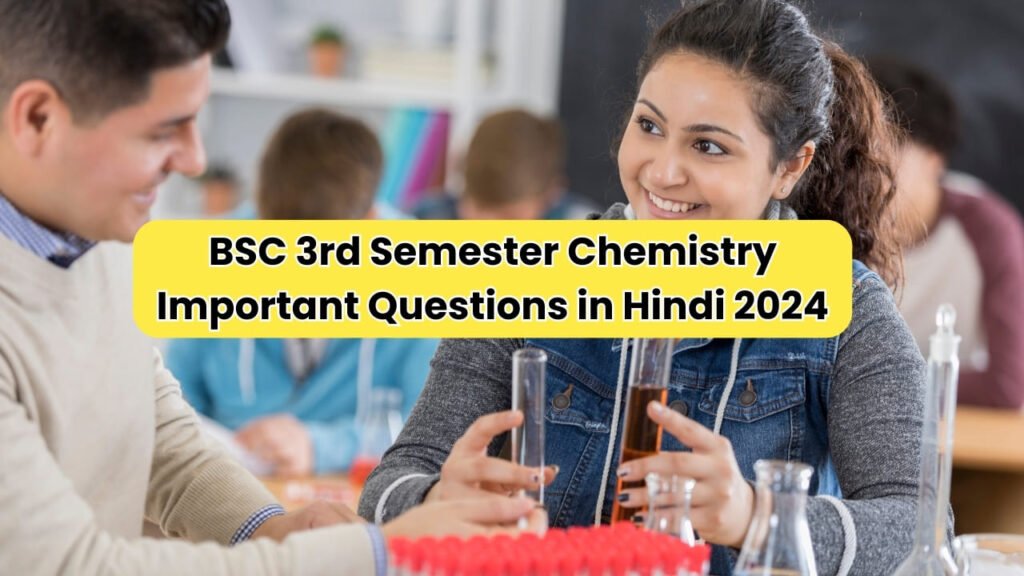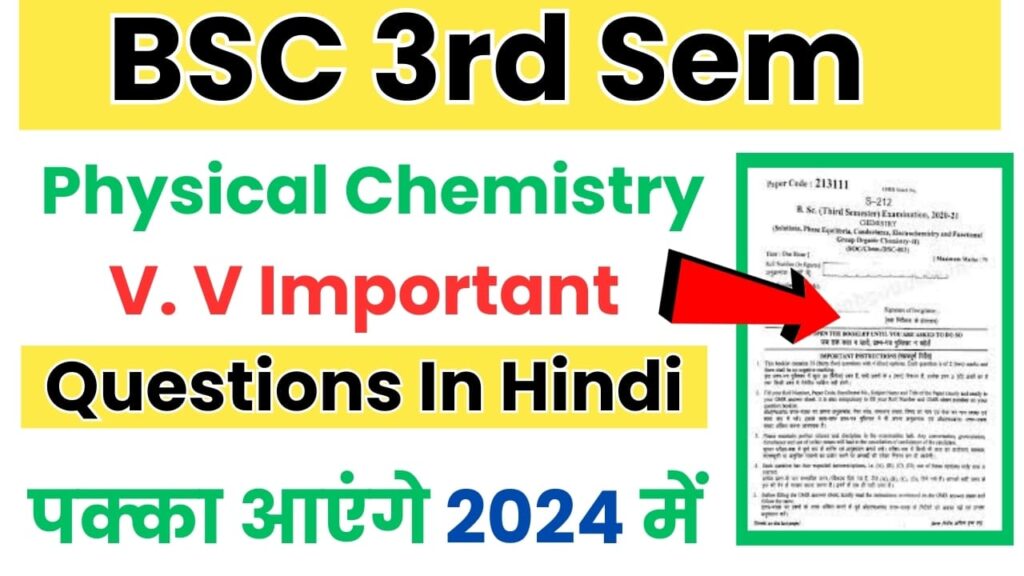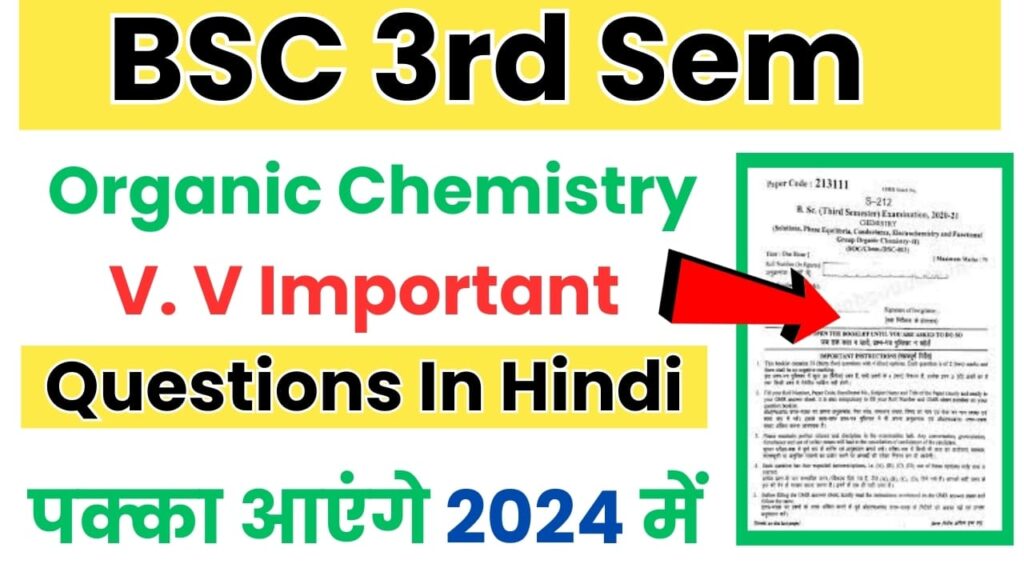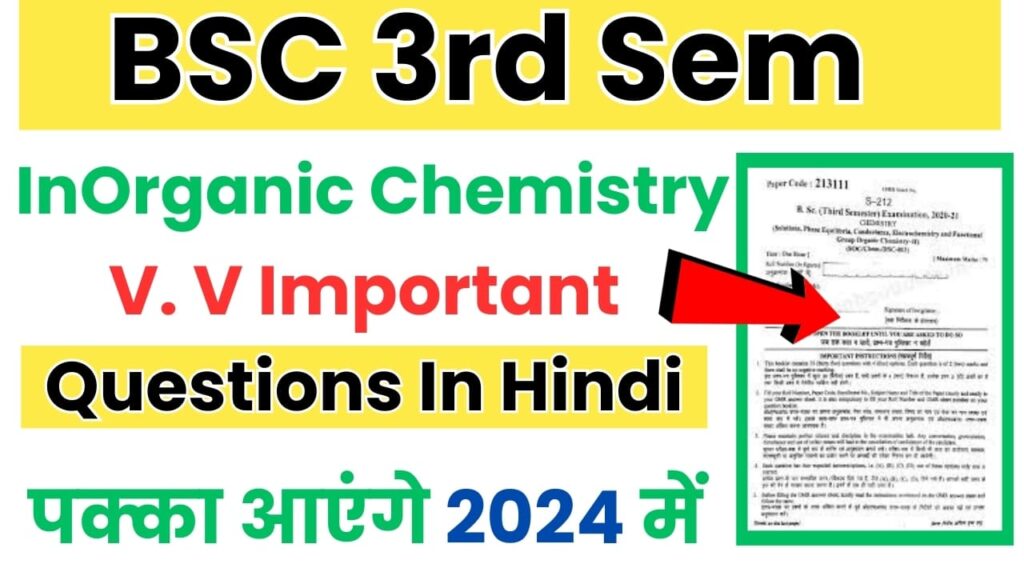नमस्कार साथियों क्या आप जानना चाहते है BSC 3rd Semester Chemistry Important Questions in Hindi 2024 के बारे में? दोस्तों आपका स्वागत है इस लेख में, हम आपको BSC 3rd Semester Chemistry Important Questions In Hindi के साथ BSC 3rd Semester inorganic chemistry important questions, BSC 3rd Semester organic chemistry important questions, BSC 3rd Semester physical chemistry important questions 2024 के बारे में सब कुछ बताएंगे।
जैसा कि आप जानते हैं Chemistry एक बहुत ही दिमाग लगाने वाला subject है, तो इस लेख में हमने BSC 3rd Semester Chemistry Important Questions इकट्ठा किया है जो कि आपको पढ़ने में मदत करेंगे अगर आप इस लेख में बताए हुए Important Questions को एक बार रट लेंगे तो आप समझ लो 60% syllabus cover हो जाएगा, तो BSC 3rd Semester Chemistry Important Questions In Hindi की पूरी सूची पढ़ने के लिए इस लेख को अंत तक जरूर पढ़ें ।

यह BSC 3rd Semester Chemistry Important Questions के महत्वपूर्ण प्रश्न 2024 प्रतिष्ठित संस्थानों के अनुभवी शिक्षकों द्वारा तैयार किए गए हैं, इन प्रश्नों के पेपर में आने की अधिक संभावना है, इसलिए इन्हें अच्छी तरह से तैयार करें।
Contents
BSC 3rd Semester Chemistry Important Questions in Hindi 2024

Q1: अल्कोहल क्या है? (What is alcohol?)
Q2: इथिलीन ग्यास क्या है और इसके लाभ? (What is ethylene gas and its uses?)
Q3: अल्डेहाइड के विशेष गुण? (Special properties of aldehydes?)
Q4: कार्बोनिक अम्ल के उपयोग? (Uses of carbonic acid?)
Q5: पोलिमर क्या हैं? (What are polymers?)
Q6: आर्केन क्या है और इसके प्रकार? (What is alkene and its types?)
Q7: एथन का रासायनिक नाम क्या है? (What is the chemical name of ethane?)
Q8: सूजी (सेमोलिना) का रासायनिक सूचक क्या है? (What is the chemical indicator of semolina?)
Q9: पोलिमर इतिहास? (History of polymers?)
Q10: आइयोडिन का रासायनिक नाम? (Chemical name of iodine?)
Q11: परमाणु क्या होता है? (What is an atom?)
Q12: अपयथामी क्या होता है? (What is a catalyst?)
Q13: उत्पादक गैस क्या है? (What is a producer gas?)
Q14: रेजिन के उपयोग? (Uses of resin?)
Q15: कार्बनिक और अकार्बनिक यौगिकों में अंतर? (Difference between organic and inorganic compounds?)
Q16: प्लास्टिक की विशेषताएँ? (Characteristics of plastic?)
Q17: अम्लों के प्रकार? (Types of acids?)
Q18: धातु का नाम क्या है? (What is the name of the metal?)
Q19: अणु क्या है? (What is a molecule?)
Q20: क्या होता है उर्वरक? (What is fertilizer?)
Q21: कार्बनिक और अकार्बनिक कार्बन के उदाहरण? (Examples of organic and inorganic carbon?)
Q22: कार्बनिक यौगिकों के प्रकार? (Types of organic compounds?)
Q23: अधातु का नाम क्या होता है? (What is the name of the ore?)
Q24: गैस की प्रकृति क्या है? (What is the nature of gas?)
Q25: नाइट्रोजन का रासायनिक नाम? (Chemical name of nitrogen?)
Q26: उत्सर्जन यौगिक क्या है? (What is a released compound?)
Q27: यौगिकों के विशेष गुण? (Special properties of compounds?)
Q28: आल्डिहाइड का रासायनिक नाम? (Chemical name of aldehyde?)
Q29: धातु क्या है? (What is metal?)
Q30: जल का नाम क्या है? (What is the name of water?)
BSC 3rd Semester Physical Chemistry Important Questions in Hindi 2024

Q1: वन लेबरेट रीक्शन क्या है? (What is a one-leberate reaction?)
Q2: परमाणु की आंतरिक ऊर्जा क्या है? (What is the internal energy of an atom?)
Q3: जब आंतरिक ऊर्जा और परमाणु की आकार के बीच कोई संबंध होता है, तो किसे कहते हैं? (What is called when there is a relationship between internal energy and the size of an atom?)
Q4: विरियम के दो विकरण क्या हैं? (What are the two isotopes of uranium?)
Q5: पाउली का प्रतिबिंदु सिद्धांत क्या है? (What is the Pauli Exclusion Principle?)
Q6: बोल्ट्जमन ने किसे कहा और क्यों? (Who did Boltzmann call and why?)
Q7: आंतर्मिक ऊर्जा और तापमान के बीच कैसा संबंध होता है? (What is the relationship between internal energy and temperature?)
Q8: ग्रहण प्रक्रिया क्या है? (What is the process of eclipse?)
Q9: क्या फ्रेडरिक सूरे की धारा का सूत्र है? (What is the formula of Frederick Soddy’s stream?)
Q10: संतृप्ति क्या है? (What is satisfaction?)
Q11: उत्ताप विश्लेषण क्या है? (What is heat analysis?)
Q12: समान्तर धातु क्या है? (What is a parallel metal?)
Q13: दबाव और ऊर्जा के बीच कैसा संबंध होता है? (What is the relationship between pressure and energy?)
Q14: कौन कोयला प्रदूषण क्या है? (What is coal pollution?)
Q15: बीना लूप के ग्रहण क्या है? (What is the eclipse without loop?)
Q16: संतृप्ति की गणना कैसे की जाती है? (How is satisfaction calculated?)
Q17: सूत्र क्या है एनट्रॉपी का? (What is the formula of entropy?)
Q18: कैसे काम करता है कैलोरीमीटर? (How does a calorimeter work?)
Q19: बायोडाइजेशन क्या है? (What is bio-digestion?)
Q20: क्या है अधिगत ऊर्जा? (What is acquired energy?)
Q21: वाणिज्यिक उत्पादन क्या है? (What is commercial production?)
Q22: ग्रहण क्यों होता है? (Why does an eclipse happen?)
Q23: क्या है स्थिरता? (What is stability?)
Q24: कैसे काम करता है बायोगैस प्लांट? (How does a biogas plant work?)
Q25: आंतरिक ऊर्जा की अवधारणा क्या है? (What is the concept of internal energy?)
Q26: गैलिलियन ग्रहण क्या है? (What is Galilean eclipse?)
Q27: क्या है अर्द्ध-संचयित ऊर्जा? (What is semi-conserved energy?)
Q28: वैशिष्ट्य क्या है? (What is specificity?)
Q29: धारण ऊर्जा क्या है? (What is latent energy?)
Q30: आदर्श गैस क्या है? (What is an ideal gas?)
BSC 3rd Semester Organic Chemistry Important Questions in Hindi 2024

Q1: कार्बनिक रसायन क्या है? (What is organic chemistry?)
Q2: आल्डहाइड और केटोन में अंतर क्या होता है? (What is the difference between aldehydes and ketones?)
Q3: स्नायु-स्फीति क्या होती है? (What is electrophilic substitution?)
Q4: एल्कोहल के उपयोग क्या हैं? (What are the uses of alcohols?)
Q5: आई.पी.सी. क्या होती है? (What is I.P.C.?)
Q6: संबंध रासायनिक जानकारी क्या है? (What is stereochemistry?)
Q7: सिल्वर मिरर टेस्ट क्या है? (What is the silver mirror test?)
Q8: बेंजीन यौगिक की संरचना और विशेषताएँ क्या हैं? (What are the structure and properties of benzene compounds?)
Q9: एथेन और प्रोपेन के रिएक्टिविटी में क्या अंतर है? (What is the difference in reactivity between ethene and propene?)
Q10: नित्रोबेंजीन के उपयोग क्या हैं? (What are the uses of nitrobenzene?)
Q11: एथानोल की अमाइन के प्रतिक्रियात्मक प्रकार क्या हैं? (What are the reaction types of ethanol with amines?)
Q12: सार्बनिक यौगिक का अर्धजैविक वर्गीकरण क्या है? (What is the semi-biological classification of organic compounds?)
Q13: नाइट्रिल्स के रसायनिक गुण क्या हैं? (What are the chemical properties of nitriles?)
Q14: नाइट्रोबेंजीन क्या है? (What is nitrobenzene?)
Q15: स्पर्मिंग द्रव्य क्या है? (What is a spermatizing substance?)
Q16: इलेक्ट्रॉन डोनर और इलेक्ट्रॉन अवलम्बी क्या होते हैं? (What are electron donors and electron acceptors?)
Q17: मायने की रासायनिक शब्दावली क्या होती है? (What is the significance of chemical nomenclature?)
Q18: अल्कोहल की उत्पत्ति क्या है? (What is the origin of alcohols?)
Q19: कार्बनिक यौगिकों के बीच संयोजन क्या है? (What is conjugation among organic compounds?)
Q20: आई.पी.सी. में आइयोडोफार्म रियेक्शन क्या होती है? (What is the iodoform reaction in I.P.C.?)
Q21: एल्कोहल की संरचना क्या होती है? (What is the structure of alcohols?)
Q22: बेंजीन के अलाईलिक और विनाईलिक विकास क्या है? (What are the allylic and vinylic developments of benzene?)
Q23: इमाइड रसायन क्या है? (What is an imide compound?)
Q24: अल्डोल की संरचना क्या होती है? (What is the structure of aldol?)
Q25: नित्रोबेंजीन के फायदे क्या हैं? (What are the benefits of nitrobenzene?)
Q26: आल्कोहल का विश्लेषण क्या है? (What is the analysis of alcohols?)
Q27: नाइट्रोबेंजीन की विशेषताएँ क्या हैं? (What are the characteristics of nitrobenzene?)
Q28: स्नायु-नुकीली विकास क्या है? (What is nucleophilic substitution?)
Q29: एल्कोहल के निर्माण के प्रमुख स्रोत क्या हैं? (What are the main sources of alcohol production?)
Q30: अल्कोहल के प्रतिक्रियात्मक प्रकार क्या हैं? (What are the reactive types of alcohols?)
BSC 3rd Semester Inorganic Chemistry Important Questions in Hindi 2024

Q1: किस प्रकार आप निम्नलिखित को साधारित रूप से वर्गीकृत कर सकते हैं: (How can you classify the following substances in a systematic manner:)
Q2: धातुओं और अम्लों के बीच महत्वपूर्ण विभिन्नताएं और समानताएं क्या हैं? (What are the important differences and similarities between metals and non-metals?)
Q3: सूत्र प्रारूपों का वर्णन कीजिए और उनका उदाहरण दीजिए। (Describe the formulae of compounds and provide examples.)
Q4: क्रिस्टल संरचना और उसके प्रकारों का विस्तारपूर्व विश्लेषण कीजिए। (Examine the crystal structure and its types in detail.)
Q5: विद्युतचुम्बकीयता और उसके सिद्धांतों को समझाएं। (Explain magnetism and its principles.)
Q6: कॉम्पाउंड्स के बारे में विस्तार से बताएं। (Elaborate on compounds.)
Q7: प्राथमिकता और द्विविधता के लिए सूत्र प्रारूपों का विवेचन कीजिए। (Discuss formulae for priority and duality.)
Q8: इलेक्ट्रॉन यायावरण की परिभाषा और उसके महत्वपूर्ण गुणों की व्याख्या कीजिए। (Define electron configuration and explain its significant properties.)
Q9: रासायनिक बंधों की व्याख्या कीजिए। (Explain chemical bonds.)
Q10: रसायन गुणों का महत्वपूर्ण विश्लेषण करें। (Analyze the important characteristics of chemicals.)
Q11: धातु और अम्लों के गुणों का तुलनात्मक विश्लेषण कीजिए। (Compare the properties of metals and non-metals.)
Q12: केवल धातुओं और अम्लों की प्रमुख विशेषताएँ लिखें। (List the major characteristics of metals and non-metals only.)
Q13: स्नायु सम्बंधी विधियों का विश्लेषण करें। (Analyze the methods related to conductivity.)
Q14: संयोजन और विघटन प्रक्रियाओं की व्याख्या कीजिए। (Explain the processes of combination and dissociation.)
Q15: अविघटन व परिविघटन की प्रक्रिया क्या है? (What is the process of dissociation and decomposition?)
Q16: संयोजन और विघटन के प्रक्रियाओं का विवेचन करें। (Discuss the processes of combination and dissociation.)
Q17: इलेक्ट्रॉनिक व्यवस्था की परिभाषा और प्रकारों की व्याख्या कीजिए। (Define electronic arrangement and explain its types.)
Q18: यौगिक और अयौगिक विशेषताएँ क्या हैं? (What are the characteristics of compounds and non-compounds?)
Q19: रासायनिक यौगिकों की प्रमुख विशेषताएँ लिखें। (List the main characteristics of chemical compounds.)
Q20: अयौगिक यौगिक की प्रमुख विशेषताएँ लिखें। (List the main characteristics of non-compound compounds.)
Q21: आवर्त सारणियों की संरचना के बारे में विस्तार से बताएं। (Elaborate on the structure of periodic tables.)
Q22: आवर्त सारणियों के आदिकों और तत्वों के बीच रिश्ते की व्याख्या करें। (Explain the relationship between periods and elements in the periodic table.)
Q23: धातु और अम्लों के बीच क्रम सूची और संवाद का विवरण कीजिए। (Describe the arrangement and interaction between metals and non-metals in the periodic table.)
Q24: अनुप्रमुख संयोजन और विघटन क्या हैं? (What is the meaning of subsidiary combination and dissociation?)
Q25: अयौगिक संयोजन और विघटन की प्रक्रियाएं क्या होती हैं? (What are the processes of non-compound combination and dissociation?)
Q26: आवर्त सारणियों के आदिकों के बारे में विस्तार से चर्चा करें। (Discuss in detail about the periods of the periodic table.)
Q27: आवर्त सारणियों के तत्वों की संरचना की व्याख्या करें। (Explain the structure of elements in the periodic table.)
Q28: कैसे आवर्त सारणियों की योजना तय की जाती है? (How are the periodic tables arranged?)
Q29: आवर्त सारणियों में तत्वों के परमाणु संरचना के बारे में बताएं। (Tell us about the atomic structure of elements in the periodic table.)
Q30: आवर्त सारणियों में तत्वों के प्रमुख गुण क्या हैं? (What are the main properties of elements in the periodic table?)
Also Read: BSC 2nd Semester Chemistry Important Questions in Hindi 2024! रटलो 90% यही आएंगे
हमें उम्मीद है कि इस लेख की मदद से आपको BSC 3rd Semester Chemistry Important Questions In Hindi 2024 के बारे में जानकारी मिल गई होगी।
दोस्तों आपको यह पोस्ट कैसी लगी कृपया हमें कमेंट सेक्शन में बताएं और यदि आपके कोई प्रश्न हों तो बेझिझक हमसे Comment Box में पूछ सकते हैं। यदि आपको यह पोस्ट उपयोगी लगी तो कृपया इसे दूसरों के साथ साझा करें।